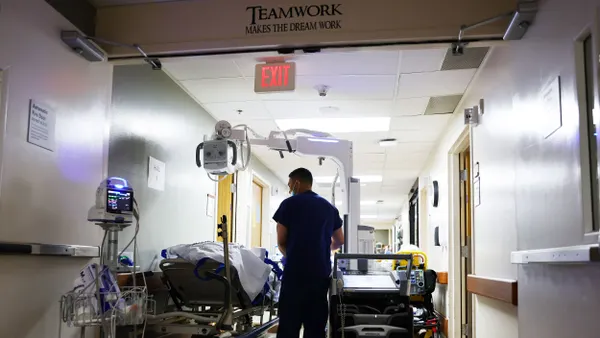It’s time for supply chain leaders to rethink distribution beyond the hospital
Healthcare costs and labor pressures continue to climb, supply chain disruptions and shortages persist, and health system executives are demanding savings from operational leaders.
For healthcare supply chain leaders, the mandate is clear: Reduce costs and waste, strengthen resiliency, and improve clinician engagement—all while navigating unpredictable demand and ongoing labor shortages.
At the same time, care delivery is shifting beyond hospitals into non-acute settings such as outpatient clinics and ambulatory surgery centers (ASC). Based on a claims analysis, Advisory Board estimates that up to $50B in hospital volumes could leave the hospital to the freestanding setting.[i]
While these sites offer opportunities to lower costs, they also expose the limitations of a hospital-centric supply chain model.
This raises a critical question: Can acute care distributors effectively serve non-acute sites?
On the surface it may seem logical, but in reality, stark operational differences exist.
This article debunks seven common misconceptions about non-acute distribution and offers a roadmap for supply chain leaders expanding their reach beyond hospital walls.
Misconception 1. “One distributor can cover both acute and non-acute needs just fine.”
Acute and non-acute sites operate in fundamentally different environments. Acute distribution is built for centralized facilities, bulk shipments and dedicated supply chain teams. Non-acute sites are decentralized, diverse and often lack space to store inventory—requiring smaller, more frequent deliveries. Forcing an acute model onto these sites presents the risk for supply shortages, higher costs (e.g., expedited shipments), and disruptions to care continuity.
Non-acute distribution also requires specialized capabilities across product categories. Cold chain handling for specialty pharmaceuticals, just-in-time lab reagent replenishment and device-specific kitting are examples of needs that exceed what a hospital-focused distributor typically manages. Consolidating these across categories under a purpose-built partner can reduce complexity and risk.
Misconception 2. “Non-acute supply chains don’t need specialized expertise.”
Each non-acute care setting has unique requirements, with workflows, acuity levels and priorities varying widely. For example, behavioral health facilities may need medication management but minimal medical/surgical products; home health providers require portable wound care kits; and ASCs demand strict surgical and sterilization supplies. Without specialized distribution, these differences can lead to clinician frustration when they lack the correct product/service mix to care for their patients.
These requirements span categories—from pharmaceuticals to surgical packs to diagnostics—making category-specific expertise essential for non-acute distribution success.
Misconception 3. “Customization for non-acute sites drives up costs and creates noncompliance.”
The goal of non-acute supply chain is not unchecked customization but smart standardization. Health systems need one formulary, invoice and ordering platform to control spend—while giving non-acute sites the ability to manage smaller spaces, limited staff and variable demand. Strategies like low unit of measure (LUM) distribution and localized stocking provide adaptability without sacrificing compliance or efficiency.
Specialized non-acute partners can also help consolidate fragmented spend, particularly in areas like lab testing, by reducing reliance on multiple direct manufacturer contracts and streamlining sourcing under one umbrella.
Misconception 4. “Service expectations are the same across acute and non-acute sites.”
Hospitals have teams to handle supply chain issues; most non-acute sites do not. Clinicians cannot afford to spend time keeping track of deliveries or resolving back orders. Non-acute distribution requires high-touch support, responsive service and flexible models that keep clinicians focused on patients. This level of planning and service not only prevents supply-related care delays and complications but also strengthens continuity of care—supporting providers’ goals under value-based payment models.
Misconception 5. “It’s risky to add another distributor because it will cause noncompliance with our GPO and primary distributor.”
Many supply chain leaders fear that introducing a second distributor could result in noncompliance with the health system’s group purchasing organization (GPO) contracts, primary distributor and formulary.
But a dual-distributor model can be structured to maintain compliance. By keeping acute and non-acute spend aligned under the same formulary, health systems can unlock the benefits of specialized non-acute distribution without jeopardizing pricing, contracts or standardization.
That said, implementing a dual-distributor strategy requires planning. Aligning IT systems, synchronizing data and maintaining a unified formulary across acute and non-acute sites can be complex. Close collaboration among supply chain, IT and clinical teams is critical to ensure seamless communication, accurate inventory tracking and consistent product availability.
Financial and reimbursement workflows add another layer of complexity. Acute settings often have case rates or diagnosis-related group (DRG) based reimbursement that bundle drug and supply costs into one payment. Conversely, non-acute sites frequently rely on individual claims for each therapy or procedure, so delayed prior authorizations or denials directly impact their ability to reorder expensive supplies. Distributors that provide tailored financing or credit terms help mitigate this risk and ensure access to high-cost therapies that can have life-or-death implications for patients.
Misconception 6. “Consolidating everything under one acute distributor builds resilience.”
The COVID-19 pandemic proved the opposite. Health systems that relied solely on an acute-focused distributor found themselves at a disadvantage when non-acute sites were deprioritized or left out of key allocations. Separating acute and non-acute supply chains creates greater agility, better aligns clinical and operational workflows, strengthens supplier relationships, and ensures continuity of care across all settings.
Resilience also depends on better forecasting and sourcing strategies. Non-acute demand is decentralized and variable: Labs face sudden testing surges, ASCs need procedure-based inventory planning and specialty therapies often require patient-specific scheduling.
Acute-style forecasting creates waste and stockouts. Specialized distributors can support sites with forecasting tools customized to the non-acute environment, higher levels of safety stock and diversified sourcing strategies—ensuring products are available when and where they’re needed.
Misconception 7. “Innovation only matters in the hospital supply chain.”
Non-acute care is increasingly driving new models such as telehealth, hospital-at-home, and remote monitoring. Supporting these models requires agile distribution, with advanced tools like real-time analytics, AI-driven forecasting, and tailored solutions for diverse care sites. A tech-enabled non-acute distributor isn’t a convenience—it’s a competitive advantage in delivering efficient, patient-centered care.
Why McKesson Medical-Surgical is the Right Partner for Non-Acute Distribution
As health systems extend care beyond hospital walls, the right distribution strategy becomes critical to balancing cost, efficiency and resilience.
McKesson’s purpose-built non-acute infrastructure—spanning nationwide next-day delivery, tailored logistics models, technology integration, and clinical consulting—equips healthcare organizations with the tools to streamline operations, improve financial performance and strengthen the care continuum.
“Non-acute care is one of the fastest-growing segments in healthcare, and it demands a supply chain strategy designed around its unique challenges,” said Deborah Haywood, GM/Vice President, Health Systems at McKesson Medical-Surgical. “We’ve built our non-acute distribution model to give health systems confidence that every site—whether an ASC, behavioral health clinic, or patient’s home—has the right products, delivered the right way, every time. Our goal is to be more than a supplier; we’re a partner in advancing efficient, patient-centered care.”
[i] The $50 billion shift: Services at risk of shifting out of the hospital, Advisory Board, https://www.advisory.com/topics/market-trends/2024/11/50b-shift-services-at-risk-of-shifting-out-of-hospital










